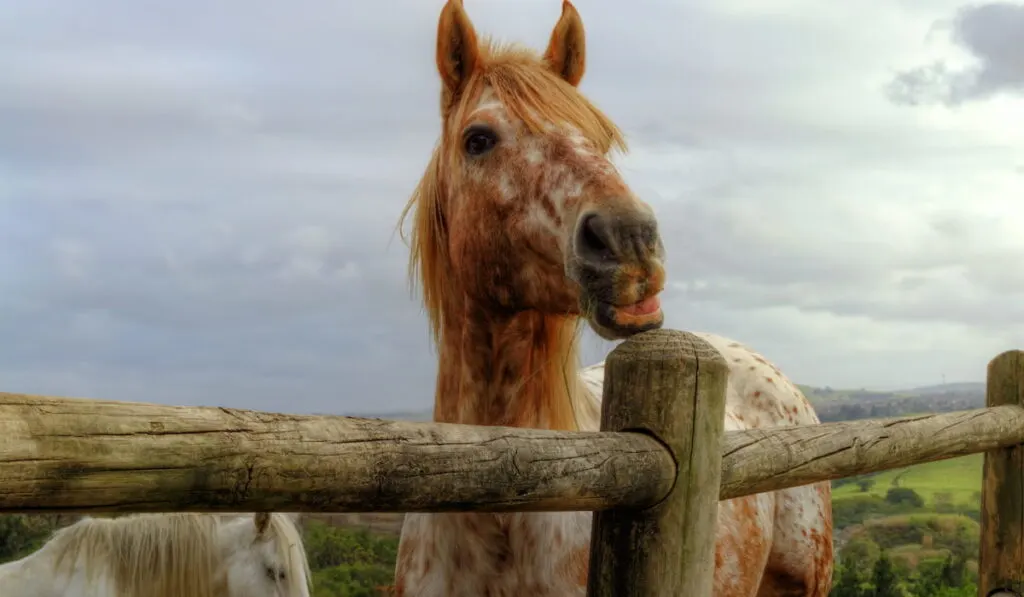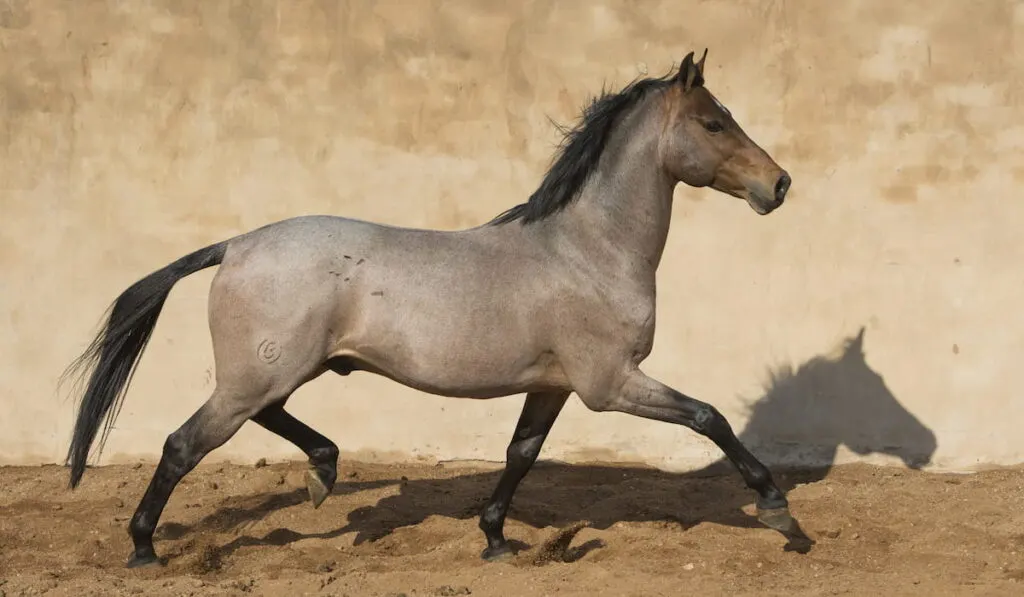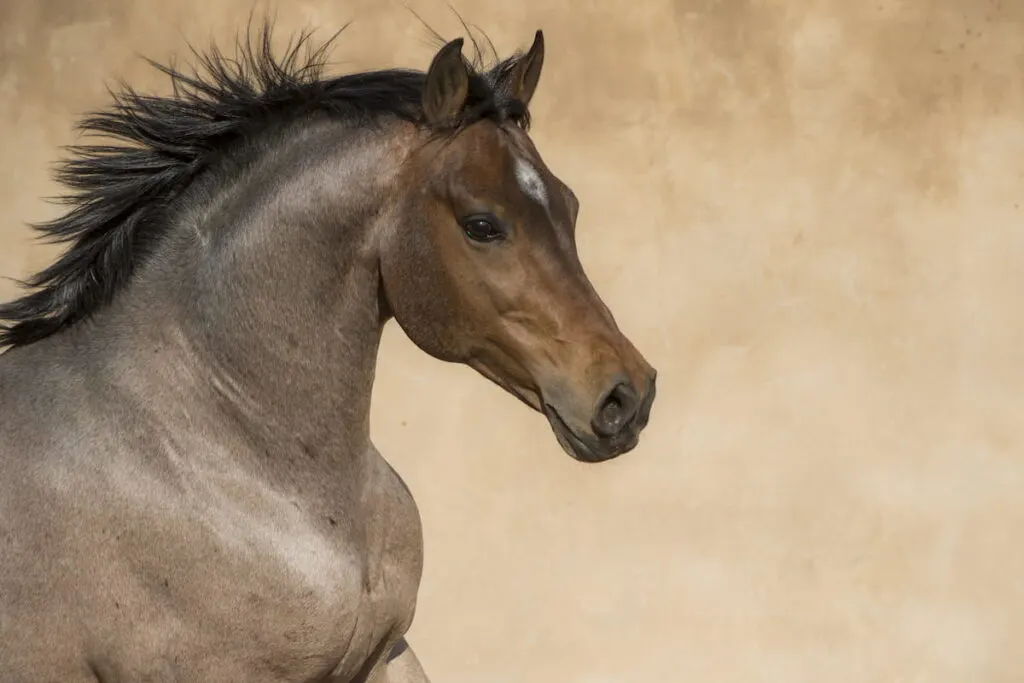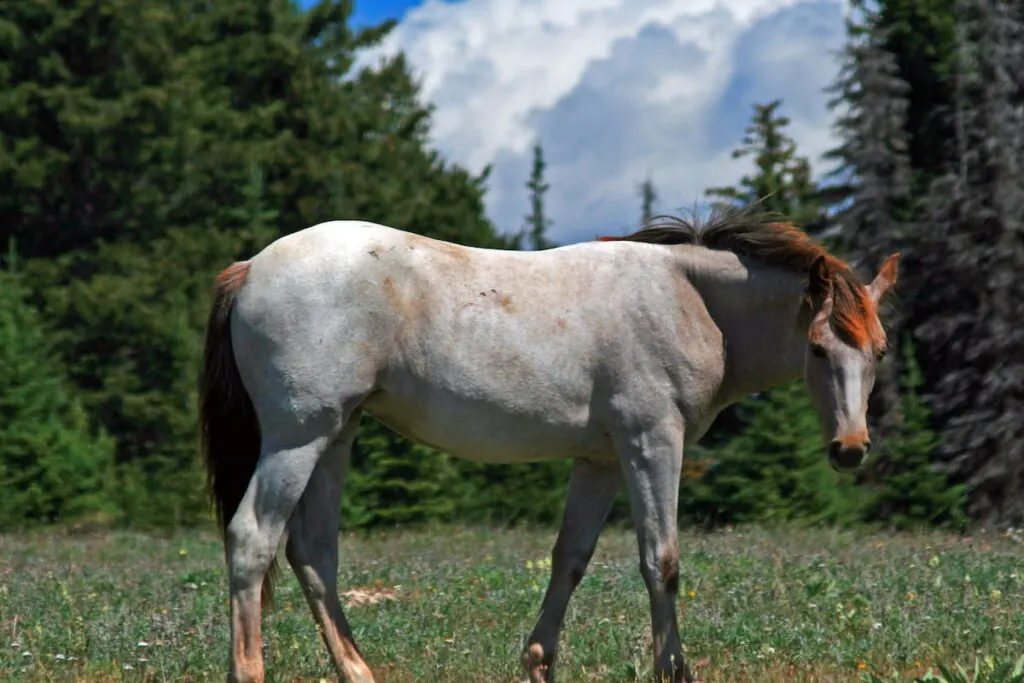The strawberry roan horse is a blush-colored beauty that turns heads wherever he goes.
These horses have a reddish tint to their coats, and they look like they’ve been dusted with fresh snow or a soft coating of powdered sugar.
However, not all pink horses with this characteristic frosted look are technically “strawberry roans.”

Here’s what you need to know about these majestic equines.
Table of Contents
What is a strawberry roan horse?
Roaning is a genetic coat pattern that affects a horse’s base color (which is either black or chestnut) by lightening the body color with a consistent intermingling of white hairs.
Blue roans have black base coats, red and strawberry roans have chestnut base coats, and bay roans have chestnut base coats as well, but are distinguished by their black points.
The terms “red roan” and “strawberry roan” are often used interchangeably, as “strawberry roan” is an older word to describe these pink red-roan horses.
With the advent of using “bay roan” to describe red roans with black points, “strawberry roan” usually refers to horses with reddish or flaxen points instead.
Strawberry roans will have solid reddish legs and faces (although sometimes with white markings), and solid reddish or flaxen manes and tails.
The color of the overall coat itself can range from nearly solid chestnut with just a little bit of roan markings, to fully light pink everywhere but the mane, tail, face, and lower legs.
Strawberry Roan vs Red Roan
Trying to accurately describe equine coat colors can be tricky, and the terminology can change over time as we learn more about the specific genetic codes that create each individual horse’s pattern.
In an older era, a horse with a blueish tint on a black coat was a blue roan, and a horse with a reddish tint on a chestnut coat was a red or strawberry roan.
Breeders and equine geneticists began to take it a step farther, differentiating “bay roans” as red roans with black points, rather than lumping them in with the other lighter-colored strawberry red roans.
The bay coat color comes from the agouti gene acting on a red base coat, which gives the horse its black points.
The American Paint Horse Association and the American Quarter Horse Association both changed their coat color descriptions to officially separate bay roans from other red roan horses.
Strawberry roan is an older and more colloquial term that you may see in a for-sale ad on a light sorrel horse with chestnut points.
Other terms like “lilac roan,” “sorrel roan,” “chestnut roan” (this one is favored by geneticists), or “honey roan” are all used to describe various shades of red roan horses.

Strawberry Roan Color Genetics
All horses can attribute their beautiful patterns and colors to their genes; and equine coat genetics can get pretty complicated.
For most casual horse owners, you don’t really need to know whether your horse is a “true” genetic strawberry roan or an imposter – unless you plan on breeding them or submitting them to a registry with strict coat color requirements.
All horses have a main base coat color – red (chestnut) or black. Other genes interact with theses base colors to create the wide array of patterns and markings that we see today.
Scientists have discovered that true roaning is caused by a specific gene, although they are still figuring out exactly how it works.
Because the classic roaning pattern is a dominant trait, it will be expressed in the horse’s phenotype (appearance) if the parent carries the roaning allele on their genotype.
Two non-roan horses cannot produce a roan foal, and a roan foal must have at least one roan parent to be a true roan – otherwise it may have an “imposter” coat pattern instead.
Each genotype has two alleles, described here as “Rn” for “roaning”, and “N” for “normal” (without roaning).
Offspring receive one allele from each parent, and that will determine their genotype (and therefore, their phenotype). The chances of producing a roan horse look something like this:
- Roan Parent (Rn/Rn) x Roan Parent (Rn/Rn or Rn/N) = 100% chance Roan Baby (Rn/Rn or Rn/N)
- Roan Parent (homozygous Rn/Rn) x Normal Parent (N/N) = 100% chance Roan Baby (Rn/N)
- Roan Parent (heterozygous Rn/N) x Roan Parent (Rn/N) = 75% chance Roan Baby
- Roan Parent (Rn/N) x Normal Parent (N/N) = 50% chance Roan Baby
Not all horse breeds carry the roaning genotype, which makes it impossible to get a strawberry roan horse in certain breeds if the horse has purebred lineage.
However, there’s a genetic test (the Roan Zygosity Test) available from UC Davis that can give you a complete analysis of your horse’s genotype and let you know how likely it is for them to throw a roan foal of their own (or if you just want to know for sure). (source)
This test is most reliable for AQHA and APA horses, but it can still give you a good picture of your horse’s genotype if you think it has the roan gene.

Strawberry Roan Horse Breeds
The classic roan gene is found in many breeds, although it’s more prevalent in some than others.
For example, true strawberry roans are plentiful in the American Quarter Horse or American Paint Horse breeds – and grade horses, mustangs, or AQHA or APA crosses may have roaning as well.
This gene is not present in purebred Thoroughbreds or Arabians, but these breeds may display roaning that is caused by “imposter” genes instead.
Strawberry Roan Imposters
True strawberry roans are often characterized by the striking, even intermingling of white hair in the coat pattern that fully lightens the coat color everywhere except the points.
But, foals can sometimes present with a pattern that may look like traditional roaning – but is actually something else entirely. (source)
Gray
One of the main characteristics of roaning is that the pattern doesn’t change over time.
Sometimes foals are born with a traditional bay roan pattern, but it lightens up as they age.
This happens often with gray horses, who may be born solid chestnut or black and become a light dapple gray over time.
If a “roan” foal pops out of two very solid parents, you’ll likely end up with a gray instead.
Red Dun
At first glance, a red dun could be mistaken for a strawberry roan.

They both have the lighter body color and darker reddish points, along with the solid mane and tail.
Duns get their coloring from a dilution gene called the dun factor, rather than a roaning gene.
They also have no white hair intermixed with their base coat color, it’s just a lighter overall shade.
Rabicano
While true roaning is an even mixture of white hairs, a rabicano roaning pattern is limited to certain areas.
It’s usually more pronounced at the flanks and the top of the horse’s tail.
This bit of white hair can also be called a “skunk” tail, and hair arranged in rings may be called a “coon” tail.
Because the rabicano pattern is not controlled by the same gene as the classic roaning pattern, it can show up in breeds like Arabians and Thoroughbreds, and the white hairs might spread over time while the horse is young.
Sabino
The characteristic jagged edges of sabino markings may be heavily roaned, especially around the belly.
It can be difficult to tell the difference for certain without a DNA test, especially if the darker legs are covered by patches of white.
If the horse belongs to a breed that cannot be a true roan but is listed as such on a for-sale ad, it’s likely Sabino or Rabicano. (source)
Varnish Roan
The varnish roan coat pattern is a result of the leopard-complex gene, which is what gives an Appaloosa his spots.
It gives a horse the same strawberry roan-like appearance, but it can change and lighten over time in certain spots.
Varnish roan foals are often born dark or with spots, and “roan out” as they grow. (source)
Famous Strawberry Roans in Popular Culture
Strawberry roans became a popular symbol of the American West, and remain immortalized in several books, movies, and songs.
- The Strawberry Roan, film, 1948. Singing cowboy Gene Autry stars in this classic western tale about capturing and taming a wild strawberry roan horse, played by Champion (Little Champ) – The “World’s Wonder Horse”.
- Strawberry Roan, young-adult novel, 1946. This heartwarming tale follows the adventures of Roscoe and his beloved strawberry roan as they navigate the exciting world of harness racing.
- The Strawberry Roan is a classic American cowboy song by Curly Fletcher, was first written as a poem called The Outlaw Bronco in 1915. Fans of the 1997 short story Brokeback Mountain (or 2005 movie) will also appreciate Ennis’ knowledge of the “salty words” to this soulful ballad. (source)
- Strawberry Roan. A 1933 western film starring Ken Maynard.
There are several more books and movies featuring a “strawberry roan”, but the main character is a cow, rather than a horse.
It’s also worth mentioning that Champion, the World’s Wonder Horse was a sorrel, and probably didn’t possess any actual roaning at all.
Source:
- https://www.geneautry.com/geneautry/champion/littlechampion.html

